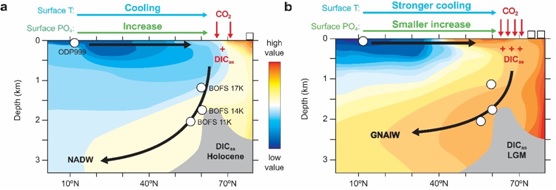
Antarctic ice core records showed that atmospheric CO2 concentration during the Last Glacial Maximum (~20,000 years ago) was about 100 ppm lower than the current warm interglacial called the Holocene (~10,000 years ago to A.D. 1850). Understanding the processes that led to past atmospheric CO2 changes is crucial and may help to constrain future carbon cycle and climate changes.
The prevailing view is that suppressed outgassing of CO2 in the Southern Ocean is the key to lowering atmospheric CO2 during ice ages. Like all other systems, atmospheric CO2 concentration is controlled by both CO2 gains (e.g., via Southern Ocean outgassing) and losses (e.g., via North Atlantic absorption). However, the sign of past North Atlantic CO2 uptake efficiency changes remains unconstrained, preventing our understanding of the entire system.
Researchers from Australia, China, the U.K. and the U.S. presented a novel approach to estimate the air-sea exchange component CO2, whose changes can be more directly linked to atmospheric CO2 variations. They found that CO2 absorption in the North Atlantic was about twice as efficient during the Last Glacial Maximum compared to the Holocene.
Their finding entitled "More efficient North Atlantic carbon pump during the Last Glacial Maximum" was published online in Nature Communications on 15 may, 2019.
This new estimate, based on geochemical data from multiple sediment cores, indicated an additional ~100 Gigatonne sequestration of carbon by the North Atlantic during the Last Glacial Maximum, equivalent to a ~50 ppm atmospheric CO2 decrease. This highlights an important role of the North Atlantic in carbon sequestration in the glacial deep ocean.
"A greater high-latitude cooling and enhanced nutrient utilization could be responsible for more efficient glacial CO2 absorption in the North Atlantic, but further studies are required to figure out the exact mechanisms," said Prof. JIN Zhangdong from State Key Laboratory of Loess and Quaternary Geology (SKLLQG) of the Institute of Earth Environment, Chinese Academy of Sciences (IEECAS).
As the Southern Ocean has long been suggested to be an important region in driving changes in atmospheric CO2, it would be interesting to apply the new approach to estimate past air-sea CO2 exchange in the Southern Ocean, according to Dr. ZHANG Fei from SKLLQG.

Schematics to illustrate more efficient atmospheric CO2 uptake during the Last Glacial Maximum (LGM) than during the Holocene. (Image by YU, et al)

86-10-68597521 (day)
86-10-68597289 (night)

86-10-68511095 (day)
86-10-68512458 (night)

cas_en@cas.cn

52 Sanlihe Rd., Xicheng District,
Beijing, China (100864)

